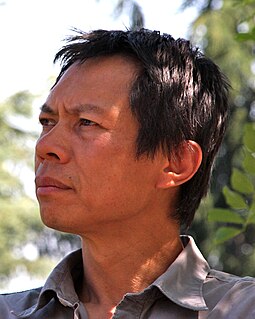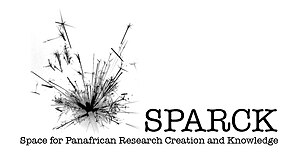
Transmediale, stylised as transmediale is an annual festival for art and digital culture in Berlin, usually held over five days at the end of January and the beginning of February.

Thomas P. Riccio is an American multimedia artist and academic. He received his BA from Cleveland State University in English Literature in 1978, his MFA from Boston University in 1982, and studied in the PhD program in Performance Studies at New York University from 1983 to 1984. Riccio has directed over one hundred plays at American regional theatres, off-off and off Broadway and has worked extensively in the area of indigenous and ritual performance conducting research and/or creating performances in: South Africa, Zambia, Burkina Faso, Tanzania, Kenya, Ethiopia, Europe, Russia, Siberia, Korea, India, Nepal, China, and Alaska. In 1993 the People's Republic of Sakha declared him a “Cultural Hero”.

Herve Yamguen is a Cameroonian painter and sculptor. Autodidact, he launched himself in painting, sculpture and he discovered a passion for the writing which enables him to wonder about its daily live. He currently works on plays.

Jonah Bokaer is an American choreographer and media artist. He works on live performances in the United States and elsewhere, including choreography, digital media, cross-disciplinary collaborations, and social enterprise.
LAb[au] is an artist group founded 1997 in Brussels, Belgium with the aim to examine the influence of advanced technologies in the forms, methods and content of art. Members are: Manuel Abendroth, Jérôme Decock, and Els Vermang. Former members were: co-founder Naziha Mestaoui, Grégoire Verhaegen, Pieter Heremans and Alexandre Plennevaux.

Vong Phaophanit and Claire Oboussier are artists based in London who have collaborated for the past 25 years. Their studio encompasses a wide variety of media including films, books, large-scale installations and photographic and sculptural works. They have created a number of major public commissions.

Goddy Leye was a Cameroonian artist and intellectual.
The Africa Centre, in Cape Town, South Africa, is structured as a not-for-profit organisation whose purpose is to provide a platform for Pan-African arts and cultural practice to function as a catalyst for social change. All the projects it conducts, facilitates or supports have some social intention. These projects are supported by a variety of Pan-African artists.
Ali Dirani is a Lebanese graphic and visual artist, musician and drummer.
Noor Afshan Mirza and Brad Butler are a London-based artistic duo, working together since the late 1990s, after meeting as students at the Royal College of Art.

Nancy Buchanan is a Los Angeles-based artist best known for her work in installation, performance, and video art. She played a central role in the feminist art movement in Los Angeles in the 1970s. Her work has been exhibited widely and is collected by major museums including the Museum of Modern Art and the Centre Pompidou.

Michèle Magema, born in Kinshasa in 1977, is a Congolese-French video, performance, and photography artist. She was born in Kinshasa, Democratic Republic of Congo in 1977. She emigrated to Paris, France in 1984, and currently resides in Nevers.
iQhiya is a network of young black women artists based in Cape Town and Johannesburg, South Africa. They specialise in a broad range of artistic disciplines including performance art, video, photography, sculpture and other mediums.

Marco Donnarumma is an Italian performance artist, new media artist and scholar based in Berlin. His work addresses the relationship between body, politics and technology. He is widely known for his performances fusing sound, computation and biotechnology. Ritual, shock and entrainment are key elements to his aesthetics. Donnarumma is often associated with cyborg and posthuman artists and is acknowledged for his contribution to human-machine interfacing through the unconventional use of muscle sound and biofeedback. From 2016 to 2018 he was a Research Fellow at Berlin University of the Arts in collaboration with the Neurorobotics Research Lab at Beuth University of Applied Sciences Berlin.
Black Salt Collective is an American queer, women-of-color artist collective that currently consists of four California-based artists and curators: Sarah Biscarra-Dilley, Grace Rosario Perkins, Anna Luisa Petrisko, and Adee Roberson. Founded in 2012, Black Salt Collective's art practice crosses disciplines and media, including performance, video, installation, sound, painting, collage, textiles, sculpture, and printmaking.
Milica Tomić is a contemporary Yugoslav-born artist. Her artistic practice traverses boundaries between photography, video, installation art and discursive, educational art, performance, and socio-political engagement. Her work encompasses collaborative and cross-disciplinary work.
Thom Kubli is a Swiss-German composer and artist known for installation art and sculptures that often deploy sound as a significant element, using digital technologies and material configurations that increase the viewers' spatial perception.
Louise Mary Potiki Bryant is a New Zealand choreographer, dancer and video artist of Māori descent. She has choreographed a number of award-winning performances, and is a founding member of Atamira Dance Company. She designs, produces and edits videos of performances for music videos, dance films and video art installations, and her works are frequently accompanied by music composed by her husband, musician Paddy Free. She often collaborates with other artists, including clay sculptor Paerau Corneal, singer-songwriter Ariana Tikao, scholar Te Ahukaramū Charles Royal and Canadian multidisciplinary artist Santee Smith. She was made an Arts Foundation of New Zealand Laureate in 2019.









